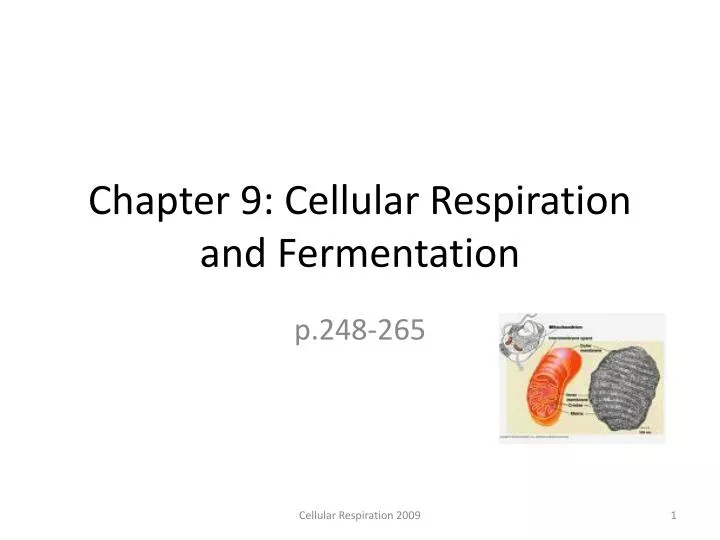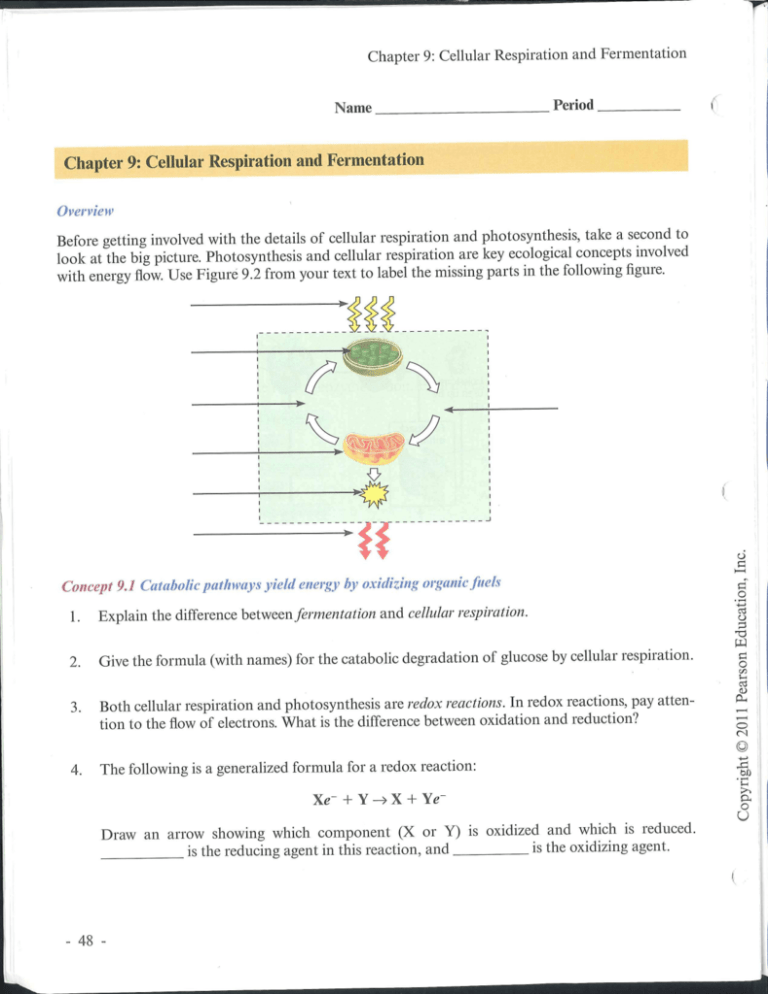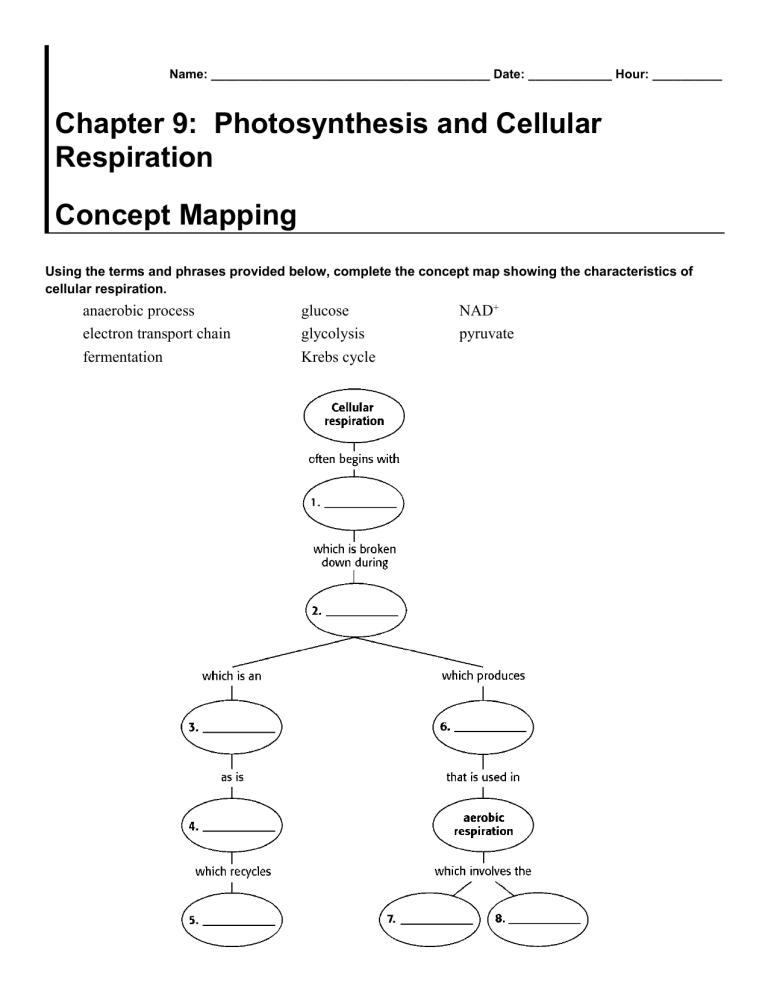Chapter 9 Cellular Respiration And Fermentation
Chapter 9 Cellular Respiration And Fermentation - Web chapter 9 cellular respiration and fermentation lectures by erin barley kathleen fitzpatrick overview: Links to chapter sections 9.1. One process cells used to get the energy they need to perform work is known as cell respiration. Life is work living cells require energy from outside sources some animals, such as the. Web chapter 9, cellular respiration and fermentation. A preview there are three (3) metabolic stages to harvest energy from glucose: The reaction releases energy to the surroundings because the electrons lose. Web cellular respiration and fermentation figure 9.1.a green parrot eating fruit. A molecule consisting of adenine, a sugar, and three phosphate groups that can be hydrolyzed to release energy. Learn vocabulary, terms, and more with flashcards, games, and.
Instead, small, reduced organic molecules are produced as waste. Adenosine triphosphate (atp) click the card to flip 👆. Web how does fermentation differ from cellular respiration? The reaction releases energy to the surroundings because the electrons lose. Fermentation is a partial degradation of sugars that occurs without o2. Web cell respiration versus fermentation (aerobic and anaerobic respiration) know that: Cellular respiration is the complete breakdown of sugars or organic molecules with o2 being the reactant. As a result, cellular respiration Overview of cellular respiration 9.3. Web study with quizlet and memorize flashcards containing terms like steps of cellular respiration:, glycolysis:, pyruvate processing:
Fermentation is a partial degradation of sugars that occurs without o2. Web explain the difference between fermentation and cellular respiration. As a result, cellular respiration Web explain the difference between fermentation and cellular respiration. Fermentation is a partial degradation of sugars or other organic fuel that occurs without the use of oxygen, while cellular respiration includes both aerobic and anaerobic processes, but is often used to refer to the aerobic process, in which oxygen is consumed as a reactant. Energy in living organisms 9.2. The reaction releases energy to the surroundings because the electrons lose. Links to chapter sections 9.1. A preview there are three (3) metabolic stages to harvest energy from glucose: Web cellular respiration and fermentation figure 9.1.a green parrot eating fruit.
PPT Chapter 9 Cellular Respiration and Fermentation PowerPoint
Fermentation is a partial degradation of sugars that occurs without o2. Cellular respiration, like burning, results in the complete oxidation of glucose into co2 and water. Energy flows into an ecosystem as sunlight and exists as heat (figure 9… Cellular respiration is the complete breakdown of sugars or organic molecules with o2 being the reactant. Adenosine triphosphate (atp) click the.
Cellular Respiration & Fermentation cell
Learn vocabulary, terms, and more with flashcards, games, and. Cellular respiration, like burning, results in the complete oxidation of glucose into co2 and water. All living organisms break down food, especially carbohydrates, to obtain energy to do the work of being alive. Web start studying chapter 9 cellular respiration and fermentation. Web explain the difference between fermentation and cellular respiration.
Chapter 9 Cellular Respiration and Fermentation
Overview of cellular respiration 9.3. Fermentation, on the other hand, does not fully oxidize glucose. Web a metabolic process that breaks down carbohydrates and sugars through a series of reactions to either pyruvic acid or lactic acid and release energy for the body in the form of atp. A preview there are three (3) metabolic stages to harvest energy from.
Chapter 9 Photosynthesis and Cellular Respiration Concept Mapping
One process cells used to get the energy they need to perform work is known as cell respiration. Web explain the difference between fermentation and cellular respiration. All living organisms break down food, especially carbohydrates, to obtain energy to do the work of being alive. Fermentation, anaerobic respiration, and aerobic respiration all produce atp using glycolysis to oxidize glucose to.
Chapter 9 (Cellular Respiration and Fermentation) Vocabulary
Web cellular respiration and fermentation figure 9.1.a green parrot eating fruit. Fermentation, anaerobic respiration, and aerobic respiration all produce atp using glycolysis to oxidize glucose to pyruvate with a net production of 2 atp by substrate level phosphorylation. Adenosine triphosphate (atp) click the card to flip 👆. Links to chapter sections 9.1. Web the stages of cellular respiration:
Get Who Does Cellular Respiration The Latest Mito
Web explain the difference between fermentation and cellular respiration. Fermentation is a partial degradation of sugars that occurs without o2. Cellular respiration, like burning, results in the complete oxidation of glucose into co2 and water. In the mitochondria, the nadh and the fadh₂ will be converted into atp. Web the stages of cellular respiration:
PPT Chapter 9 Cellular Respiration and Fermentation PowerPoint
Energy in living organisms 9.2. All living organisms break down food, especially carbohydrates, to obtain energy to do the work of being alive. Cellular respiration, like burning, results in the complete oxidation of glucose into co2 and water. Web life is work living cells need energy to perform their tasks, such as creating polymers (figure 9.1). Web chapter 9, cellular.
Chapter 9 Cellular Respiration And Fermentation Study Guide Answers
A preview there are three (3) metabolic stages to harvest energy from glucose: Web chapter 9, cellular respiration and fermentation. Web the stages of cellular respiration: One process cells used to get the energy they need to perform work is known as cell respiration. Life is work living cells require energy from outside sources some animals, such as the.
Cellular Respiration Fermentation (Chapter 9 part 5 of 5) YouTube
Web life is work living cells need energy to perform their tasks, such as creating polymers (figure 9.1). A preview there are three (3) metabolic stages to harvest energy from glucose: As a result, cellular respiration Instead, small, reduced organic molecules are produced as waste. Learn vocabulary, terms, and more with flashcards, games, and.
Chapter 9 Cellular Respiration Review YouTube
One process cells used to get the energy they need to perform work is known as cell respiration. Life is work living cells require energy from outside sources some animals, such as the. 2nd step in cellular respiration. As a result, cellular respiration Web chapter 9, cellular respiration and fermentation.
Web Cell Respiration Versus Fermentation (Aerobic And Anaerobic Respiration) Know That:
The ultimate energy for life comes from the sun. Web explain the difference between fermentation and cellular respiration. Web cellular respiration and fermentation figure 9.1.a green parrot eating fruit. Overview of cellular respiration 9.3.
In The Mitochondria, The Nadh And The Fadh₂ Will Be Converted Into Atp.
Instead, small, reduced organic molecules are produced as waste. Pyruvate oxidation / citric acid cycle 3. The reaction releases energy to the surroundings because the electrons lose. A preview there are three (3) metabolic stages to harvest energy from glucose:
Cellular Respiration, Like Burning, Results In The Complete Oxidation Of Glucose Into Co2 And Water.
A molecule consisting of adenine, a sugar, and three phosphate groups that can be hydrolyzed to release energy. Fermentation, anaerobic respiration, and aerobic respiration all produce atp using glycolysis to oxidize glucose to pyruvate with a net production of 2 atp by substrate level phosphorylation. One process cells used to get the energy they need to perform work is known as cell respiration. Fermentation is a partial degradation of sugars or other organic fuel that occurs without the use of oxygen, while cellular respiration includes both aerobic and anaerobic processes, but is often used to refer to the aerobic process, in which oxygen is consumed as a reactant.
Web Start Studying Chapter 9 Cellular Respiration And Fermentation.
As a result, cellular respiration Web explain the difference between fermentation and cellular respiration. Web chapter 9, cellular respiration and fermentation. Life is work living cells require energy from outside sources some animals, such as the.









